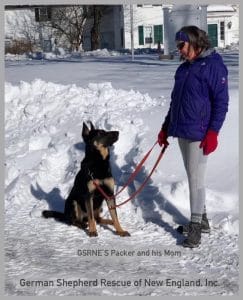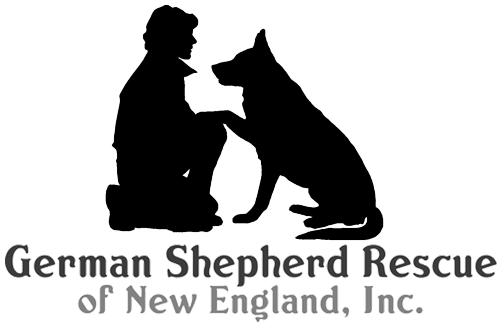No Results Found
The posts you requested could not be found. Try changing your module settings or create some new posts.
REQUIREMENTS FOR ADOPTING FROM GSRNE
There are many reasons for this policy. We regret that some great homes may be passed over because of this policy, but we feel that this policy is best for everybody involved to take the dog and family’s safety into account.
GSRNE places dogs in homes with a fenced yard.
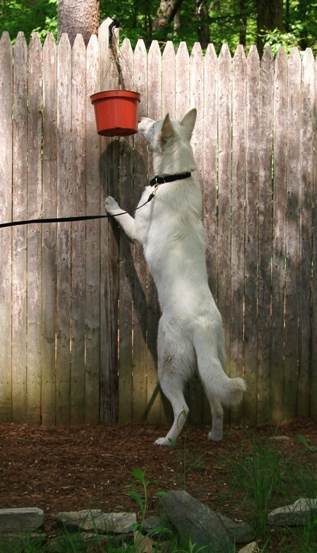
Sassy is safe in her fenced yard
Experience is the best teacher and has taught us that the safest environment for a Rescue German Shepherd includes a fenced yard or area. Generally speaking, most rescued dogs need more limitations because they need time to get to know the new owners and bond. We feel VERY STRONGLY that dogs allowed to wander unsupervised are dogs that are at a greater risk of getting lost, stolen, poisoned or struck by a car. Dogs that run loose are also at risk of exposure to rabid animals, potentially bringing this fatal disease home to the family. GSRNE requires some kind of fenced area attached to your house at the back or side door. This is to ensure the safety of the dog. Your fenced area doesn’t have to be elaborate or expensive. It does NOT have to encompass your entire yard.
The fenced enclosure is intended to guarantee a secure outdoor exercise area for the dog, but is NOT intended as a place for the dog to live. German Shepherds are highly social, people-dogs and need to be with you to be happy.
Placement: Location of the fenced area should also be taken into consideration. It needs to be attached to your house at the back or side door, so it will ensure an increased measure of safety for your dog and prove a convenience for you. It should include a lockable gate. A fence along a sidewalk or road needs to be set back at least 20 feet or be a stockade type fence.
Size: The fenced area needs to be at least 1000 square feet (for example 20’ x 50’) to provide your GSD with a comfortable, safe space in which to get some exercise and fresh air, and to eliminate, without concern of people, kids, animals or wildlife wandering into their area. Kennels or pens do not qualify, unless enclosed within a larger fenced area attached to your house. Shade and shelter from the sun and elements should also be provided as well as fresh water.
Height: We generally require at least a 5′ high fence for active dogs. We are willing to discuss a fence height exception of a 4′ fence for less active dogs.
Type of Fence: A satisfactory fence may be built of stockade, chain link, heavy wooden posts with heavy gauge wire, or metal posts with heavy gage wire, preferably with a rigid metal bar along the top. (No dog should be left unattended for any length of time in the latter type of enclosure because they are relatively easy to escape.) Equal attention should be given to the security of the fence along its bottom in order to prevent dogs from digging out.
Invisible Fencing: Major limitations of the invisible fence system are: an invisible fence does not keep out potential dangers to your dog–any dog or rabid animal may come onto your property, not all dogs can be trained to obey the system, any people coming onto your property do not have the benefit of a physical barrier between themselves and the dog, it does not keep out other dogs. This fencing is not approved because of these potential problems.
Tie-outs: The use of tie-outs or overhead runners is not safe or allowed for a German Shepherd. Dogs on tie-outs may become tangled or choke and are not able to adequately defend themselves from other dogs or animals that may enter the yard. They are easy targets for thieves, are usually not very happy dogs and tend to bark a lot. Tying out German Shepherds has been shown to increase frustration and aggression levels.
Access to the Fenced Area: GSRNE rescue dogs should only be allowed to use the fenced area when supervised, i.e. you are home or outside with the dog. Dog doors allowing your dog access to the outdoors while you are not home are also not considered safe for a rescue GSD. German Shepherds are intelligent, inquisitive dogs who should be with their families, or should be safely inside the house if nobody can supervise them. German Shepherds left outside alone even in a fenced area for long periods of time can develop problems such as digging, barking, and fence frustration at not being able to join people or dogs outside. No dog should be left unattended for any length of time in general, because it is relatively easy for the dog to escape.
Pools: If you have an in-ground pool, you must have a fence around the pool to keep your dog from falling in and drowning. We’re sorry to say that drownings have happened before, even with dogs that have spent years around pools, and we want to prevent it from happening again. Exceptions can be made if 1) your pool has graduated steps and you teach your dog how to get out of the pool using them and 2) you use a pool cover during the winter that can bear the weight of a person.
Senior or Special Needs Dogs: For some senior dogs (8 years and older) the fencing requirement may be waived. This will be approved on a case-by-case basis. We understand there are excellent adopters and dog owners that do not have a fenced yard but the fence requirement will not be waived for younger dogs.
While a secure fence is the goal of our fencing policy, a fence does not automatically make every home a good home for a rescued German Shepherd Dog. A fenced area is just a place for the dog to be off leash and safe, to get some fresh air, eliminate and to play… it is not a place for the dog to live! We regret that this policy may eliminate some homes, but our first concern must be the safety of the dogs with which we have been entrusted. Thank you for your understanding and cooperation.
Note: Dogs cannot be fostered or adopted until your fence has been inspected and all necessary repairs competed.
GSRNE places dogs in the following New England states: Massachusetts, New Hampshire, Maine, Vermont, Rhode Island, and Connecticut. If you live outside our service area, please search other GSD rescue websites for organizations outside of our area.
Thanks to Labrador Retriever Rescue, Inc. for some of the wording.
READ NEXT: If you fit all the above requirements and are interested in adopting, please go to our Adoption Process page.
BEFORE YOU ADOPT
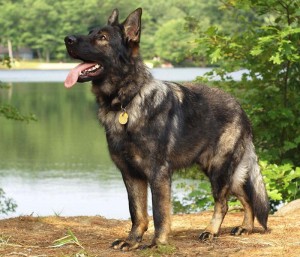
Buddy
Before you get a German Shepherd Dog, you will want to educate yourself on what the breed is like.
There are several ways to do this. Begin by reading some of the suggested material right here at GSRNE. Talk to people who own a GSD.
- Just as importantly as educating yourself on the breed, you should evaluate the following truthfully:What you want and expect from a dog as the responsible owner. This includes activity level of the dog. Don’t get a bouncy young dog when you really want a quieter dog that will be content to lie around the house all day with you.
- What the rest of your family wants and expects from a dog. This may differ from what you want. Again, consider activity level, size, sex, etc.
- What your family members can handle (which is often different from what people think they want!).
We have noted some general characteristics of these beautiful and intelligent dogs below to help you decide if a GSD would be a good fit for your family and your lifestyle.
General Characteristics of a German Shepherd Dog
The German Shepherd Dog (GSD) is a large, active dog with a double coat. This double coat sheds and sheds and sheds and sheds, year round, and produces greater volumes of fur when the dogs “blow coat” in the spring and fall. Some shed more than others, but be sure that your vacuum will become your best friend. For some owners, this is not a trivial point. Being a large dog, expect muddy paw prints in the house every time it rains.
The breed was developed for service as a herding and general purpose working animal. Their desire to “work” or do something is genetic, and is stronger in some GSDs than others. Many GSDs end up in shelters precisely because they are working animals. Their first family really just wanted a couch-potato. Think about this carefully!
Most adult GSDs are handsome, giving, loyal, active, loving, protective and intelligent. Without proper guidance and training, GSDs can be rambunctious, destructive of property, obnoxious, and exhausting to live with. It is up to you to guide your dog to suit your lifestyle and that of your family.
Many GSDs can also become overly protective/territorial if they do not receive the level of leadership in the household that they respect and want to follow. Who is really running the show in your house? Evaluate this objectively. If it isn’t you or your dog doesn’t believe it’s you, then your German Shepherd Dog will assume that responsibility himself, and will run things as a dog will, not as a human being will. (After all, he’s just a dog!) In many instances, the dog way of running the world is NOT how humans would like, and we get calls from owners about overly protective and territorial behaviors showing up and getting out of control. It all has to do with YOU.
Most, if not all, GSDs need training and a structured lifestyle to thrive and become a canine good citizen. Training is not something you do once in an 8 week obedience class…training is teaching. You need to make sure the dog is following your rules for most of the dog’s life!
In addition, your leadership skills are something you will employ all of the time. Clarity, follow-through, fairness, and showing your dog that there are immediate consequences for all actions (good and not good) make all the difference! If you do this kind of thing naturally or work on doing it, owning a GSD can be the most amazing experience of your life. If you don’t want to commit to this level of mental and physical stimulation for your dog, and to this level of leadership bearing that you and your household need to employ as a lifestyle, please check out other more suitable breeds. You won’t be sorry then.
Different types of GSDs look and behave differently, and to some degree, have different needs. Learn about these differences and ascertain what it is you really want from the dog. There are American line dogs, German line dogs, other European line dogs, etc. Many people love the idea of a novelty like a Czech-line dog, but are you really ready to take on a dog like that? Most families are NOT. By researching different types and their general attributes you can make an educated choice about what type of GSD is right for you.
GSDs are known for being an “intelligent” breed. Remember that “intelligent” can be a nice thing in that your dog can learn quickly *if* you communicate with him well. However, “intelligent” can also mean that your dog has a need for physical and mental activity and stimulation, just like an intelligent child does. A bored GSD will often find his own excitement and stimulation, which might include digging, barking, herding small children around, “creating” toys out of household furniture or the children’s toys, etc. GSDs need exercise, socialization, and mental stimulation almost every day to be on their best behavior.
Training never stops.
BE SURE TO READ: Should You Get a German Shepherd Dog?
NEXT STEP: schedule a phone interview and after that we will send you the formal adoption application. Please phone us at 978-443-2202 and leave a message. One of our adoption volunteers will return your call.
OUR ADOPTION PROCESS
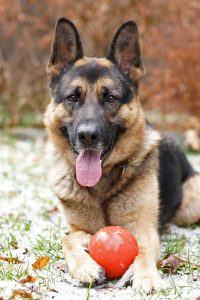
Milo
GSRNE places dogs in these six New England states (ME, NH, VT, MA, CT, RI). We cannot support long distance adoptions. If you are from outside New England, you may want to search on other GSD websites for information on GSD rescue groups throughout North America.
If any of the following situations apply to you, it is unlikely that you will qualify to adopt from GSRNE: We regret that some good homes may be passed up because of these requirements, but we feel that this policy is best for everybody involved taking the dog and family’s safety into account.
- Homes that do NOT have a physically secure fenced area (minimum 5′ high) of at least 1000 sq. ft. (ex: 20×50) that is attached to the home so when the back or side door is opened, the dog goes directly into the fenced area.
- Homes with children under the age of 7 years, whether the children live in the home or are regular visitors.
- Applicants that rent their place of residence.
If any of the above apply to your situation and you would still like to talk with someone on our Adoption Hotline Team about your situation. Please leave your name and phone number, along with a convenient time to return your call. It is important that you speak slowly and clearly so GSRNE can call you back. We try to return all calls within 48 hours.
NOTE: If you do not receive a callback within 48 hours, please call back. This means that your number wasn’t clear enough to understand. When the volunteer calls back, they will go over our requirements for adoption as well as answer any questions you might have. It’s a good idea to write down your questions so you won’t forget.
Click here to go to our Requirements for Adoption page for additional details.
After you have spoken to an Adoption Hotline Volunteer, they will send you an application (if you meet the requirements for adoption). Read every bit of the Adoption Application packet that you receive. This packet is complete with information about both GSDs in general and about adoption and how that works.
Have A Home Visit Done
Once the application is accepted, a GSRNE Home Visitor Volunteer will call you and make an appointment to visit your home to discuss the needs of a rescue German Shepherd dog with you and your family. Usually we can get this visit done within a few weeks of your application approval. This volunteer will sit down and meet with you, and check the safety of your property, etc. This is great time to ask questions, voice concerns, discuss what you love in a dog, what you would rather avoid, etc.
NOTE: We cannot “reserve” certain dogs for you to meet. Completion of the adoption application and home visit interview begins the adoption process and helps us determine which dog in our program matches best with you and your family.
We reserve the right to refuse an application if the home situation or environment is deemed incompatible with the needs of our rescue German Shepherd dog. Our requirements have been set through years of experience placing and rehoming rescue dogs. Our emphasis is on the dogs’ needs. Disqualification does not mean the prospective adopter would not be a good home, but that the situation does not meet our dogs’ best interest.
Meet the Dog!
If approved, the Adoption Coordinator will help you set up an adoption visitation appointment with the dog’s foster home to meet the GSRNE dog who best matches your family’s profile and requirements. Because GSRNE has all of our dogs living in nice foster homes, not in kennels, we do not have a facility for you to visit. GSDs do NOT do well in shelter situations, so we make sure that they are placed in a foster home until we can find a matched approved adopter for them.
This is the best way to meet a new dog. You will see how the dog lives and behaves in a home environment. Exclusive time is set aside by the foster home to be with you and your family, so that you can focus on the rescue dog you are meeting without the distractions or stress of kennel/shelter situations, or short-handed staff. You can ask whatever questions you want about the dog from the foster home that has lived with this rescue dog for over a month. Your visit can be a relaxed and pleasant experience where you and the rescue dog are the focus.
Visitations to meet a dog may be set up right away, or can take some time, depending on the availability of dog(s) that match your needs and lifestyle.
Make Your Decision
After meeting the dog that seemed to match with your requirements, it’s decision time! If there is a connection, the actual adoption begins. If the match just isn’t quite right, we’ll figure out why, add that criteria to the search, find another dog who may make a better match, and another visit will be scheduled. Because we take great care to find a dog that will match your lifestyle and preferences, it rarely takes meeting more than one, possibly two dogs, to find that ultimate new family member!
The adoption donation is $450 for dogs over 6 months up to 7 years of age, $550 for puppies up to 6 months of age and $250 for Seniors age 8 and older or “Special Needs” dogs. These donations help to defray the rescue’s boarding and veterinary expenses, but does not cover the entire expense we incur for each dog.
This adoption donation covers the following:
- Spay or neuter
- Microchip
- Heartworm, Lyme, Elrichea, and Anaplasma (4DX) test, where available, on dogs over 6 months
- Distemper, Hepatitis, Leptospirosis, Parainfluenza and Parvovirus (DHLPP) vaccination
- Rabies vaccination (dogs over 16 weeks)
- Lyme vaccination
- Fecal check and basic worming, if needed
- Blood panel for senior dogs to check vital organ functioning, or dogs with obvious health issues
- Treatment of any other health issue
- Isolation and health certificate fees if needed to bring the dog into rescue
- Leash
- Collar
- The dog’s favorite toy
- A complimentary one-year membership to German Shepherd Rescue of New England, Inc., which includes a subscription to the GSRNE newsletter.
Our organization is comprised wholly of hard-working volunteers whose only reward is seeing these wonderful German Shepherd dogs in loving homes, given another chance for a happy life. We will try to match you with a devoted, loving, loyal companion. Thank you for your interest!
Please Remember
We are all volunteers, most of whom work full-time day jobs, have our own dogs and families, and are doing this out of a desire to make a difference in the lives of needy German Shepherds. We appreciate your patience while we work through the Adoption process.
READ NEXT: Before You Adopt
#501 Elsa
“She passed with flying colors! She is so cute, isn’t she?”
You’re never too old to learn and achieve great things. Just ask GSRNE’S Elsa who just passed the CGC test and has received her Canine a good Citizen certificate at 7.5 years old. (YAY !!) Congratulations to Elsa and her mom, Nancy!!

Stay In Touch With GSRNE
Directions to Springhill Suites (Our Auction Venue)
DIRECTIONS TO SPRINGHILL SUITES BY MARRIOTT in PEABODY
43 Newbury Street, Peabody, MA 01960

Springhill Suites by Marriot in Peabody, MA
Type into your Car’s GPS: 43 Newbury Street, Peabody, MA 01960
For Directions via Google Maps: CLICK HERE
For Directions via Map Quest: CLICK HERE
Below are some rough directions on how to get to Springhill Suites by Marriott in Peabody:
From Boston, MA…
- Take Rt. 1 N towards Peabody
- Continue on US-1 N (Toll road) for 12.6 miles
- Turn right into the Springhill Suites by Marriott
From Western, MA…
- Take MA-9 E towards Boston
- Merge onto I-95N in Wesllesley
- Continue on I-95 N to Peabody for 26.7 miles
- Take exit 63B and keep left
- Turn left into the Springhill Suites by Marriott
From New Hampshire…
- Take I-93 S towards NH-101/Portsmouth/Salem/Boston
- Continue on I-93 N to Peabody
- Take exit 28A to merge onto I-95 N towards Peabody for 7.6 miles
- Take exit 63B towards Danvers and keep left
- Turn left into the Springhill Suites by Marriott
From Maine…
- Take I-95 S towards Boston
- Continue on I-95 S
- Take exit 63 for US-1 N towards Danvers and keep left
- Turn left into the Springhill Suites by Marriott
From Connecticut…
- Take I-84 E
- Merge onto I-90 E towards Boston/N.H. – Maine for 27.8 miles
- Continue on I-90 E for 16.6 miles
- Take exit 123 for I-95 N towards Boston/Portsmouth
- Take exit 63B towards Danvers and keep left
- Turn left into the Springhill Suites by Marriott
These GSDs are currently available to the right homes:
These GSDs are currently available to the right homes:
#392 Georgie
“If there ever comes a day when we can’t be together, keep me in your heart. I’ll stay there forever.”
The worst part about owning a dog is having to say goodbye, and no matter how long we have them in our lives that goodbye often feels far too soon. It is with a heavy heart that we announce that Georgie, GSRNE #392 has crossed the Rainbow bridge.
Deb and Fran you both are in our thoughts and prayers. We are so sorry for the loss of your beautiful girl, Georgie. We never seem to have them long enough. We are very grateful that she crossed the bridge peacefully knowing how much you both loved her unconditionally. Thank you for giving Georgie her lifetime of happiness with you. ♥️🐾
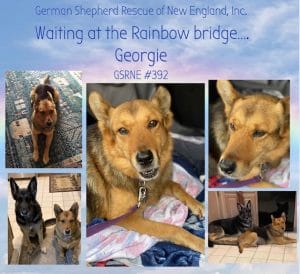
#571 Kali
She has come such a long way and listens unbelievably. Recently with all the snow, she has been able to see the deer we feed during the winter. I have her set were as soon as she sees them, I say “ah” to get her attention and she ignores them. Fortunately the deer can hop the cattle fence but Kali can’t.
I am very proud of her behavior and look forward to introducing more things to her.
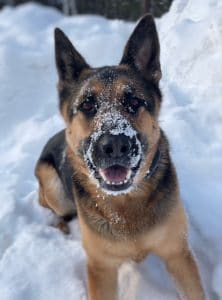
#559 Packer
Brrr….🥶 It doesn’t seem to matter how cold it is outside GSRNE’S Packer loves his long winter hikes with his Mom.
Although it depends on the individual dog, most German Shepherds don’t seem to mind the cold.
We just LOVE this boy and think he’s so handsome!
